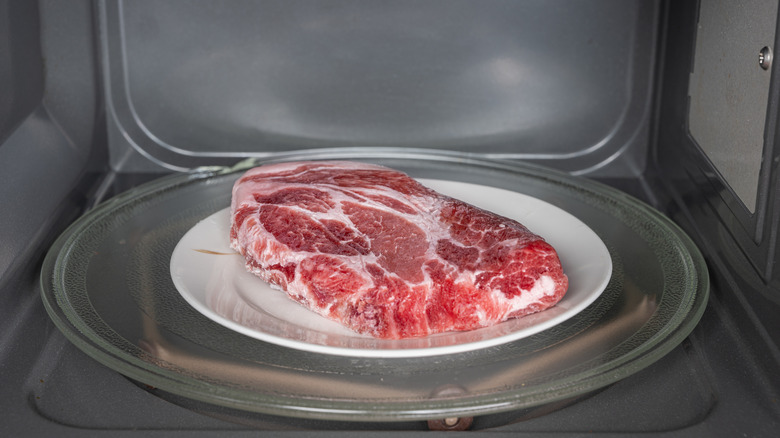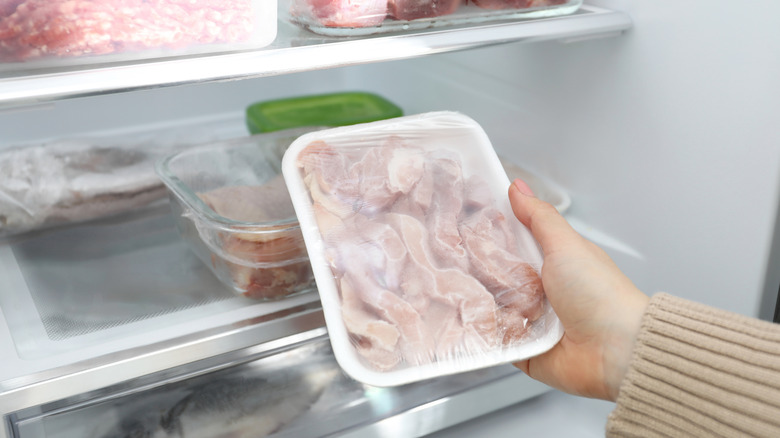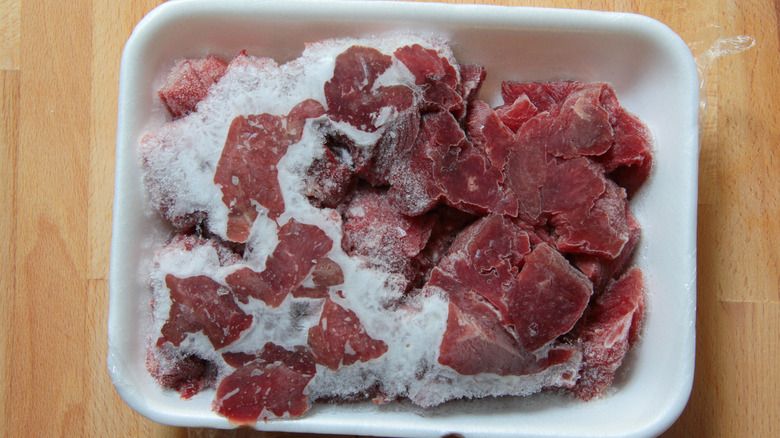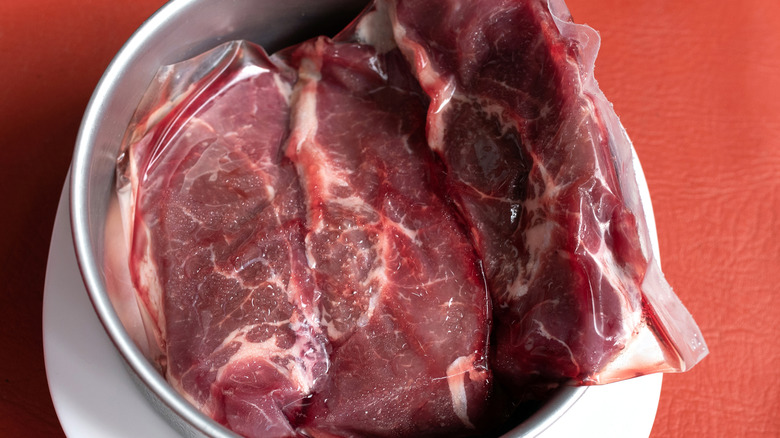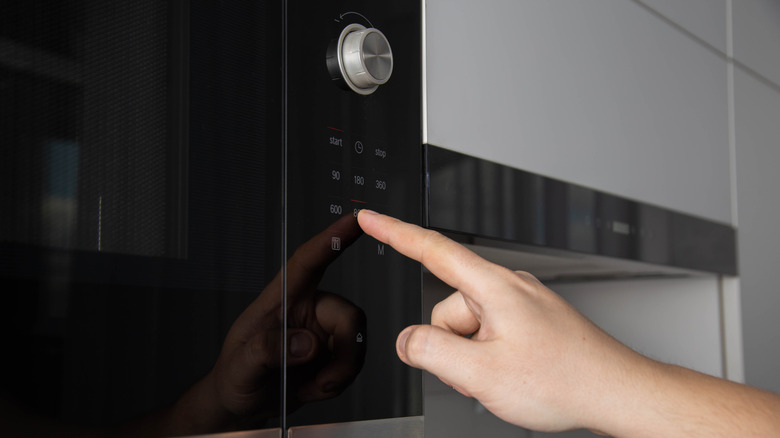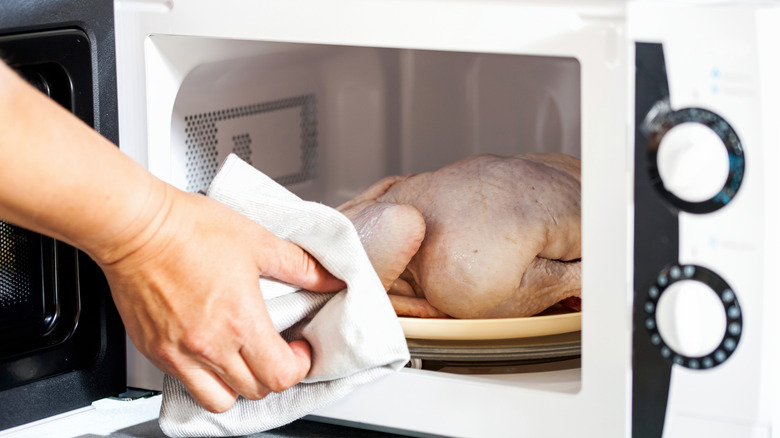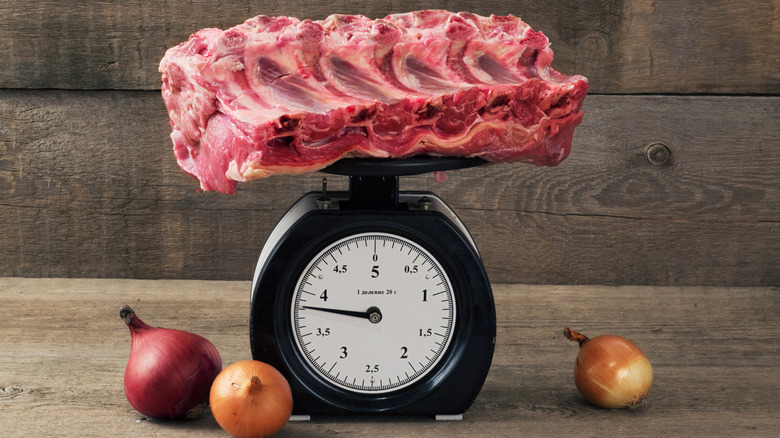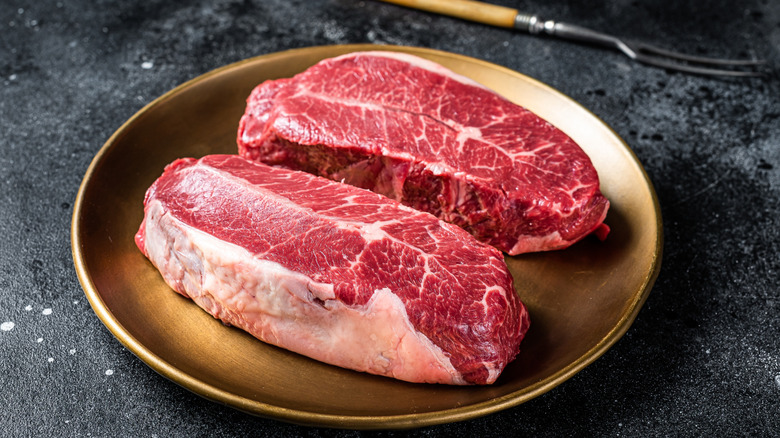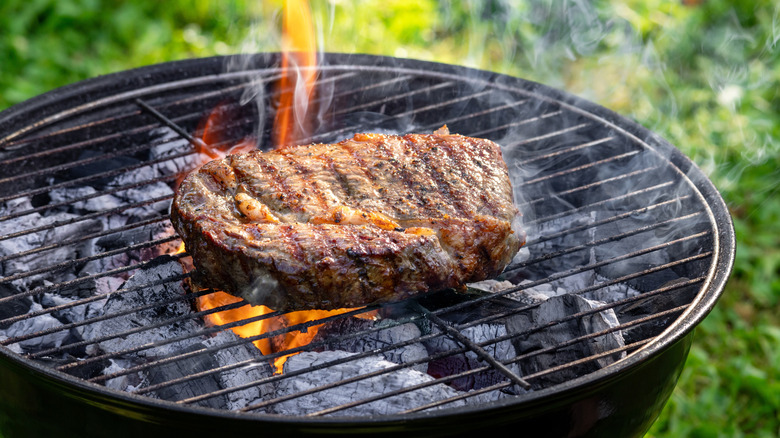The Dos And Don'ts Of Thawing Meat In The Microwave
We've all been there. You're planning a mouthwatering steak dinner for your family. As you're gathering the ingredients for your feast, you realize that the meat is still frozen solid in the freezer. You know that grilling the T-bone in that frigid state would take too long, and thawing the meat in a refrigerator or under cold water would also take hours. The good news is that your microwave can come to your rescue in just few minutes.
Most microwaves have a defrost setting that will allow you to thaw any type of meat including chicken, beef, pork, lamb, and fish from frozen. Packaged frozen food will most likely have its own thawing instructions, but there are certain guidelines to follow when defrosting meat that you froze from fresh.
Microwaves are operated by a magnetron, which generates high frequencies to heat food fast. During the defrosting process, the appliance cycles the magnetron on and off, and runs at only 20% to 30% power so that the food thaws but doesn't actually begin to cook. While this is a totally safe and convenient defrosting option when you're in a hurry, it's still important to follow certain precautions and avoid common mistakes when defrosting meat. This will help stop you getting food poisoning, as well as ensuring that the meat is juicy and delicious when it finally hits your dinner plate.
Don't use meat that hasn't been properly stored
Before thawing any meat in the microwave, make sure that it's been properly stored. According to the USDA Food Safety and Inspection Service, food kept in a freezer at zero degrees Fahrenheit will be safe to thaw, prepare, and eat. Freezing meat at the correct temperature keeps it safe because it causes bacteria to stay at a dormant state so they don't become active and multiply. Frozen meat can be stored at or below zero degrees Fahrenheit for between one and nine months, depending on the type and how it is packaged, so don't thaw and consume anything that isn't in that safe range.
Not only can improperly stored frozen food be harmful to eat, but its taste and texture may be less than ideal as well. Keeping meat frozen for too long may make its muscle fibers lose their structural integrity, resulting in a mushy piece of steak or chicken.
If you notice that your frozen meat has some discolored areas or is covered in ice crystals, these may be signs your food is freezer-burned. When meat is improperly stored and exposed to cold air, it can dry out and have an unpleasant taste and chewy texture when cooked. While freezer-burned meat may still be safe to eat, it will probably make your meal less-than-delicious.
Do put the meat in a microwave-safe container before thawing
Once you've determined that the frozen meat is safe to thaw and eat, it's important to remove it from the packaging that it was stored in and place it in a microwave-safe dish. Most likely, the meat was either in its original packaging, such as a Styrofoam tray, or wrapped in plastic wrap or foil before you put in the freezer. Plastic wrap that isn't heat-stable can break down and release harmful chemicals into your food during the defrosting process. Some types of Styrofoam may be labeled as microwave-safe, but you should never use anything containing metal, such as foil, in the appliance. Metal surfaces reflect microwave waves rather than absorbing them, which quickly increases the heat and produces sparks that may become a fire hazard.
Instead, unwrap the frozen meat and put it into either a glass, plastic, or ceramic container that is rated for microwave use. Always check the label of any container to make sure it says that it's microwave-safe. While most glass is considered microwave-safe, crystal and handmade ceramic items, such as pottery, may not be. If the pieces contain metallic paint or inlays, they're not approved for use in the microwave. Also, don't thaw meat in single-use plastic containers, such as to-go boxes, as many aren't microwave-safe. Most long-term plastic storage containers, including Tupperware items, are the perfect vessels for thawing meat in the microwave.
Don't refreeze thawed meat before cooking
If you change your mind about eating thawed meat right away, cook it before refreezing. While it may be tempting to refreeze thawed meat that you didn't use so that you can enjoy it later, it could be a food safety hazard. Defrosting meat in a microwave may bring its temperature to 40 degrees Fahrenheit or above, which allows bacteria that's already present to grow. When the temperature of the meat is between 40 degrees Fahrenheit and 140 degrees Fahrenheit, bacteria can double in just 20 minutes. If you defrost any type of meat in the microwave and it rests in what the USDA calls the "danger zone," for too long, it could cause illness.
If you cook the meat you defrosted in the microwave right away, however, you can safely refreeze it in the proper packaging at the correct temperature. Heat the meat up in any way you'd like, such as in the oven, in a pan, on the grill, until it reaches the recommended internal temperature, and then freeze it so you can reheat it and enjoy at a later time. Here's a delicious way to turn leftover burger meat into next-day lunch, for example.
Do choose the microwave defrost option
To make the microwave thawing process even more convenient, most appliances have a specific defrost button, which is typically marked with a water drop or snowflake symbol. To take it a step further, some microwave brands also have different buttons for defrosting various types of food, including meat. Microwaves generally have wattages between 700 and 1200 watts, so it's important to check your owner's manual prior to using it to thaw food. The higher wattage your appliance has, the faster your meat will thaw — and even begin to cook, if it's left in for too long. When you select the microwave's defrost option, the wattage will be reduced.
During the defrosting process, your microwave will cycle between working and resting, so you may hear the appliance turn on and off. This alternating action will ensure that the meat thaws evenly throughout, and that some portions won't be overcooked while others are still frozen. If your microwave doesn't have a defrost button, adjust the level to a setting between 20% and 30% of its full power. If you can't find your appliance's power level button, refer to the user manual, and be sure to always stick to the safest way to defrost meat in a microwave.
Don't stop defrosting until the meat is completely thawed
Although you may be excited to throw your chicken in a roasting pan with vegetables, or get your steaks on a fired-up grill, it's important to make sure the meat is thoroughly thawed before doing so. Just as you can defrost meat for too long in a microwave, you can also thaw it for too short a time period. The length of time you need to defrost the meat depends on what type it is, and how much it weighs. Using the appliance's defrost button or a lower power setting will help prevent the meat from thawing unevenly, but you'll still need to check it periodically throughout the process.
If you don't thaw the meat for a long enough time, some portions may still be frozen, especially in the center, and it can cook unevenly. To determine the meat's thawing progress, insert a food thermometer into the thickest portion of the meat to check its internal temperature. If you're defrosting separate pieces, such as chicken legs, remove the thawed ones before continuing with the others. Continue defrosting the meat in 30-second to one-minute intervals until it's thawed.
Do adjust thaw time according to meat weight
One major factor that will determine how long your meat needs to defrost is its weight. Determining the weight of your steak — or any other type of meat — before thawing it in the microwave is crucial. The general rule with most meats, including pork, beef, and chicken, is to defrost for eight to 10 minutes per pound. You can either figure the time out yourself using a bit of math, or rely on your microwave's food-specific defrost buttons if it features them. It's best to avoid using a microwave to defrost very light or small food items, such as thin fillets of fish, shrimp, or scallops, because they can go from thawed to cooked quickly.
As a quick and handy guide if your meat weighs more than a pound, thaw 1 ½ pounds for 12 to 15 minutes (or double that for twice the weight), 2 pounds for 16 to 20 minutes, and 2 ½ pounds for 20 to 25 minutes. Check the thawing progress periodically so you don't overcook the meat — this is especially important if you want to serve rare or medium-rare steak.
No matter how long you thaw your meat in the microwave, make sure that it's brought to the recommended internal temperature when it's cooked. For beef, pork, lamb, and veal, that's 145 degrees Fahrenheit, while it's slightly higher at 165 degrees Fahrenheit for all types of poultry.
Don't defrost the meat for too long
As important as it is to totally defrost your meat before cooking it, it's just as critical to not thaw it for too long. Defrosted meat should be still be cool prior to cooking. If you're thawing several pieces of meat, such as pork chops or chicken breasts, separate them. If they're frozen into one solid piece when you begin defrosting them, you can break them up as they thaw. This step is helpful if the meat pieces are different sizes or thicknesses, as they'll defrost at various speeds. For smaller pieces of meat or when the defrosting process is near the end, check the progress at short intervals so you don't over-thaw.
A big concern with defrosting any type of meat for too long is that its taste and texture may be off. The last thing you want to do is ruin an expensive cut of steak or high-quality seafood by thawing it in the microwave longer than necessary. You'll be able to see if your meat is beginning to cook, as it will change color. For instance, red or pink ground beef or steak may begin to turn brownish as it reaches a level of doneness.
Do flip and rotate the meat periodically during the defrosting process
Another important step when defrosting raw meat in a microwave is flipping and rotating it periodically throughout the thawing process using a fork or a knife. Avoid using your fingers to prevent contamination. Although many appliances go through automatic cycles to ensure even thawing, it's still important to move the meat around, especially if some portions are thicker than others.
While most microwaves have rotating turntables, others don't, so you'll need to move the meat manually every few minutes. Larger pieces of meat, such as substantial steaks or a whole chicken, should be moved around more often to prevent uneven heating. Break up big chunks of meat, including stew-size cubes of beef or chicken wings, as they begin to defrost. You can also pull apart fish fillets or thinner pieces of meat after defrosting for a minute or two.
Rotate and rearrange meat such as steak and roasts on the plate as they begin to thaw to make sure they defrost uniformly. If you're not sure how often to rotate the meat, do it at least once at the halfway point. As another trick, cover the meat with a damp paper towel while it's defrosting to prevent it from drying out. This is especially important if you're thawing large pieces for an extended period of time, as the process can cause moisture loss. The moist towel will create a damp environment inside the appliance without effecting the thaw time.
Don't risk cross-contamination when handling defrosted meat
Perfectly thawed and cooked steak or chicken won't matter if you're too sick to enjoy it, so make sure to handle raw meat with care to prevent foodborne illness. Even though you can't see or smell bacteria on raw meat, it's there and can multiply quickly in the right circumstances. During all stages of defrosting, it's important to pay attention to a few basic food handling safety precautions to avoid cross-contamination.
The USDA terms cross-contamination as "the transfer of harmful bacteria to food from other foods, cutting boards, and utensils." Be mindful of contaminating items and surfaces, including countertops, after you've handled raw meat. If you season the meat with spices, salt or pepper, it's also important to clean off the jars, because they're the most contaminated thing in your kitchen.
Other ways to prevent cross-contamination include washing your hands with warm, soapy water after touching raw meat, and wiping down any surfaces it comes into contact with using a bacteria-killing cleanser. After cutting raw meat, thoroughly wash the cutting board, knife, and any other utensils you used in hot water using dish soap, and don't use the soiled tools to cut other foods. Also, never reuse any of the packaging, such as foil or plastic wrap, that the raw meat was stored in. Clean inside your microwave with a warm, soapy rag before using it again. Finally, don't serve the cooked meat in the container it was defrosted in.
Do cook thawed meat immediately
If you're in such a hurry to defrost your meat that you're using a microwave to do it, you'll probably want to cook it soon after it's thawed. This is a good thing, since it's critical to prepare defrosted meat immediately to prevent the growth of harmful bacteria that can cause illness. If you defrost the meat in another way, such as in the refrigerator, you can wait one to two days to cook it, but since a microwave heats the protein to a higher degree, you won't have that extra time. And you should definitely avoid letting the thawed meat hang out for long in the "danger zone" of 40 to 140 degrees Fahrenheit before you cook it.
For the best results, however, you can allow the meat to rest for just a minute or two before cooking. This will allow the meat to come to room temperature so that it will be cooked evenly no matter what technique, such as grilling or roasting, that you use. If you have leftovers, you can safely refreeze the cooked meat in the proper packaging and correct freezer temperature. For reference, here are some more key mistakes to avoid when freezing steak.
